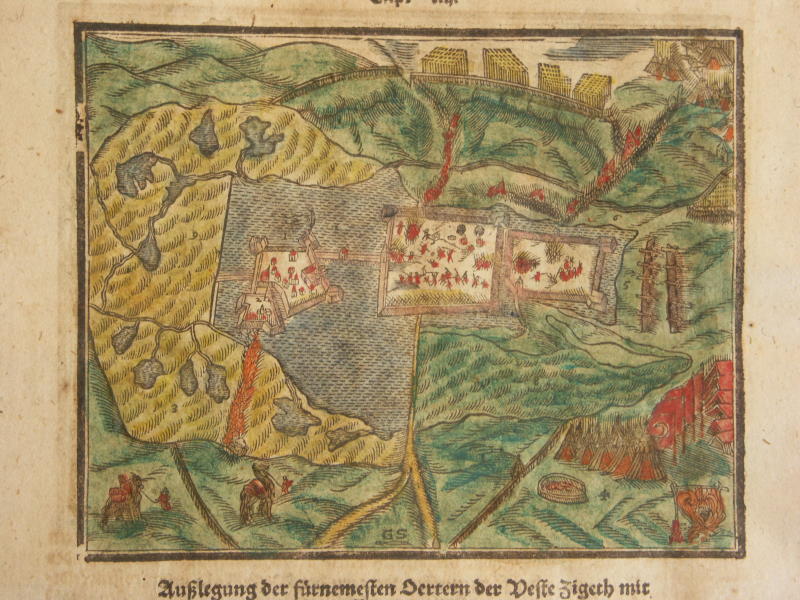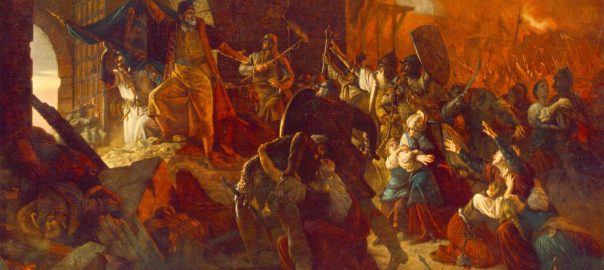I’ll interrupt my normal procedure here of picking out a few bullet-points (or headlines) from the events of the year, to focus on a single theater of world affairs in which two big things happened simultaneously in 1566 CE. This was Szigetvár, a fortified city in the south of today’s Hungary, which was captured– after a dramatic and punishing battle– by a massive Ottoman army nominally headed by the 72-year-old Suleiman the Magnificent, who was sitting in a tent overlooking the battlefield.
Suleiman and his Grand Vizier Sokollu Mehmed Pasha, who was the true operational commander of the Ottoman forces, arrived at the battlefield in early August with an army of 100,000 men commanding 300 cannons; and the siege and tough fighting against the city’s complex series of fortifications then commenced.

On September 6, Suleiman died. English-WP tells us: “His death was kept secret at great effort, with only the Sultan’s innermost circle knowing of his demise. This was because the Ottomans feared that their soldiers would give up the battle if they knew that their leader died, so his death was kept secret for 48 days. A courier was dispatched from the camp with a message for Suleiman’s successor, Selim II. The courier may not even have known the content of the message he delivered to distant Asia Minor within a mere eight days.”
The following day, Sokollu Mehmed Pasha launched the final assault on the city as planned and it fell within the next couple of days among many grisly scenes.

The English-WP page on the Siege of Szigetvár provides a short, informative, and very dramatic description of all these events. (Szigetvár’s defenders had laid a deadly booby-trap before they surrendered their final redoubt! To keep the news of Suleiman’s death a secret, even his personal physician had to be strangled! And so on… )
The broader impact of these events of September 1566 was that, though the Ottomans had “won” at Szigetvár, they had done so only at a very heavy cost to their men, with an estimated 20,000 to 30,000 of them killed during the assault; and they were clearly not in any shape to push any further toward the Habsburg capital of Vienna. Some 70 years later, French churchman and statesman Cardinal Richelieu would reportedly describe this battle as the one that “saved [Western] civilization.”
(The battle would live on in the imagination of many in Christian Europe. The image in the banner above is Zrinyi’s Charge from the Fortress of Szigetvár by Bertalan Székely, 1879-1885.)
In 1566, and especially coming so close after the Ottoman navy’s failure to capture Malta the year before, it probably seemed clear that the Anatolia-born Ottoman dynasty had for now reached the limit of its ability to expand into (or, in the case of Malta, toward) Europe. There was also the matter of the stability of the post-Suleiman order within the Ottoman dynasty– though the grand old man himself seems to have taken care of that– for the moment, at least– by arranging to have the two sons most likely to challenge Selim’s succession murdered over recent years.
Regarding the Ottoman relationship with (other) European powers, within the still very complex, chaotic, and contested political order obtaining among the continent’s “Christian” powers, it had always been the Spanish/Habsburg constellation that had been most inimical to the Ottomans; whereas, as we’ve seen, the French king– also a Catholic– often allied with the Ottomans, especially against the Spanish/Habsburgs.
The attitude of the Habsburg ruler who was closest to Szigetvár was interesting. The knight/adventurer who organized and led the defenses of the city was not a Habsburg: he was a Croatian called Count Nikola IV Zrinski. The Habsburg person most closely involved in that region was the “Holy Roman Emperor” Maximilian II, a Vienna-born nephew of the deceased HRE+Spanish King Charles, and thus a cousin of current Spanish King Philip. Among Maximilian’s numerous titles he was supposed to also be “King of Hungary and Croatia”, though that claim was contested. Anyway, during the Siege of Szigetvár, Maximilian had 80,000 soldiers with him in the nearby city of Győr– but he did nothing at all to use them in order to help Zrinski! Then, the following year he sent two ambassadors to Istanbul to meet with Selim II…
But let me not get ahead of myself. My sense here is that, as the imminence of any “threat” from the Ottomans receded from the planning of Christian-European leaders, they would have more time over the years after 1566 to plan for ordering their own chaotic political order(s) a lot better– plus, for accelerating the projects that more of them were now engaged in, to build globe-girdling (and always violence-backed) global trading empires.
